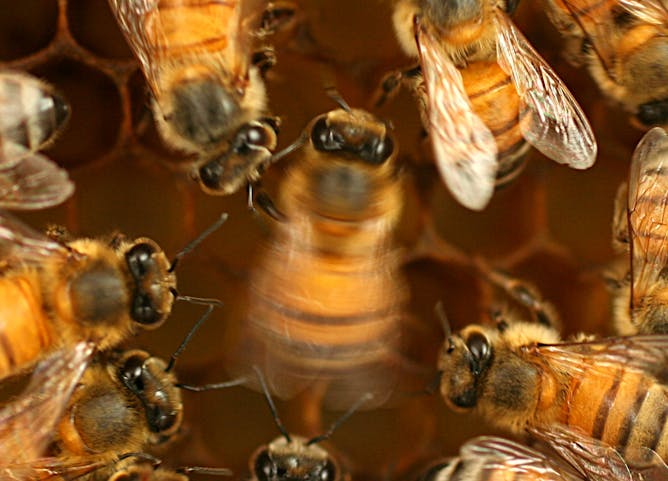|
Honeybees have a complex system for communicating with each other about food sources – they waggle their abdomen in a specific, repeated pattern. Other bees in the hive watch this “waggle dance” and follow its instructions to get first dibs on the best meals.
But, as biologist James Nieh from the University of California, San Diego and his team have found, this dance isn’t something bees just wake up one morning knowing how to do. Younger bees need to learn it from older bees in the hive – it’s culturally transmitted, similar to how children learn language from their parents. And, as with human language, the bees’ waggle dance varies from region to region, like different dialects.
Nieh and his team devised an experiment to get to the bottom of how this generational hand-off happens.
Also today:
|

|
Mary Magnuson
Assistant Science Editor
|
|

A honeybee is performing the waggle dance in the center of this photo to communicate the location of a rich nectar source to its nestmates.
Heather Broccard-Bell
James C. Nieh, University of California, San Diego
Honeybees possess one of the most complex examples of nonhuman communication. New research suggests that it is learned and culturally passed down from older to younger bees.
|
Education
|
-
Alexandra Mislin, American University
A negotiation expert offers practical tips for getting the salary or promotion you want.
-
Jason W. Osborne, Miami University
As sports betting becomes more prevalent, so do the risks to college athletes, gaming experts argue.
|
|
Arts + Culture
|
-
Timeka N. Tounsel, University of Washington
Big-name awards can certainly be a boon for Black filmmakers and actors. But they don’t reflect the breakthroughs that have been made in the types of Black stories that are getting told.
|
|
Health + Medicine
|
-
Susan Lawrence, University of Tennessee; Susan E. Lederer, University of Wisconsin-Madison
This particularly physical kind of philanthropy caught on in the mid-20th century.
|
|
Economy + Business
|
-
Prachi Gala, Kennesaw State University
Strong values and principles are key traits in effective business leaders – but they can come with tendencies to take fewer risks and be less proactive or innovative.
|
|
Ethics + Religion
|
-
Timothy Gabrielli, University of Dayton
‘I see the church as a field hospital,’ Pope Francis once said – not a place where superficial solutions will do much good.
|
|
Politics + Society
|
-
Thaddeus L. Johnson, Georgia State University; Natasha N. Johnson, Georgia State University
The US has one of the highest incarceration rates in the world. When it comes to violent offenders and the Black community, the system isn’t working, argue criminologists.
|
|
|
|
From our international editions
|
|
|
|
|
|
|
|---|
-
More of The ConversationLike this newsletter? You might be interested in our weekly and biweekly emails: Trying out new social media? Follow us: -
About The ConversationWe're a nonprofit news organization dedicated to helping academic experts share ideas with the public. We can give away our articles thanks to the help of foundations, universities and readers like you. |
|
| |
| |
| |
| |
|
|